 W
WMiguel de Cervantes was an Almirante Cervera-class light cruiser that served in the Spanish Navy. She fought in the Spanish Civil War on the Republican side, before joining the post-war Spanish Navy. She was ordered by a Royal Decree on 31 March 1926, as part of a naval construction project headed by Counter admiral Honorio Cornejo.
 W
WAndalucia (F72) is the second ship of five Spanish-built Baleares-class frigates, based on the American Knox class design, of the Spanish Navy.
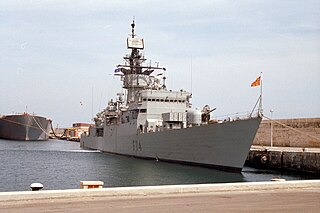 W
WAsturias (F74) is the fourth ship of five Spanish-built Baleares-class frigates, based on the American Knox class design, of the Spanish Navy.
 W
WAudaz (P-45) is an offshore patrol vessel and the fifth of the Meteoro class created for the Spanish Navy. It is the fourth Navy ship to carry this name. The patrol vessel was built in the Navantia's shipyard in San Fernando.
 W
WBaleares (F71) is the lead ship of five Spanish-built Baleares-class frigates, based on the American Knox class design, of the Spanish Navy.
 W
WUSS Noa (DD-841) was a Gearing-class destroyer of the United States Navy, the second Navy ship named for Midshipman Loveman Noa (1878–1901).
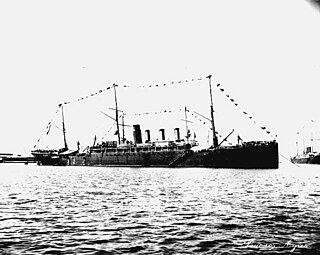 W
WBuenos Aires was a merchant ship requisitioned for use as a transport by the Spanish Navy in June and July 1898 during the Spanish–American War.
 W
WThe Meteoro-class offshore patrol vessel, also known as Buque de Acción Marítima (BAM), are new modular offshore patrol vessels of the Spanish Navy adapted to different purposes from a common base, manufactured by Navantia. The BAMs combine high performance with mission versatility, a high commonality with other ships operated by the Spanish Navy. Acquisition and lifecycle costs are reduced.
 W
WCanarias (F86), is the last of the six Spanish-built Santa Maria-class frigates, based on the American Oliver Hazard Perry-class design, of the Spanish Navy.
 W
WCantabria (A15) is a replenishment oiler operated by the Spanish Navy. Acquired to provide logistical support for the Spanish fleet, Cantabria was commissioned in 2010. Cantabria is the second-largest naval ship currently operated by the Spanish, behind Juan Carlos I.
 W
WCataluña (F73) is the third ship of five Spanish-built Baleares-class frigates, based on the American Knox class design, of the Spanish Navy.
 W
WThe Descubierta and Atrevida were twin corvettes of the Spanish Navy, custom-designed as identical special exploration and scientific research vessels. Both ships were built at the same time for the Malaspina Expedition. Under the command of Alessandro Malaspina (Descubierta) and José de Bustamante y Guerra (Atrevida) the two vessels sailed from Spain to the Pacific Ocean, conducting a thorough examination of the internal politics of the American Spanish Empire and the Philippines. They explored the coast of Alaska and worked to reinforce Spain's claim to the Pacific Northwest in the aftermath of the Nootka Crisis. After crossing the Pacific Ocean, the government in the Philippines examined. Exploration and diplomatic reconnaissance followed, with stops in China, New Zealand, Australia, and Tonga.
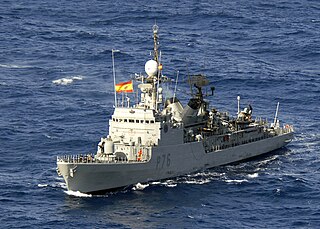 W
WThe Descubierta-class corvettes were a series of corvettes built for the Spanish Navy in the late 1970s and early 1980s. These ships were also sold to the Egyptian Navy and the Moroccan Navy. The ships were designed in cooperation with the German company Blohm & Voss, based on the João Coutinho-class corvettes which were designed in the late 1960s for the Portuguese Navy, by the Portuguese naval engineer Rogério de Oliveira. A larger version was proposed for a second batch but the Spanish Navy chose to build the American Oliver Hazard Perry-class frigates under licence instead.
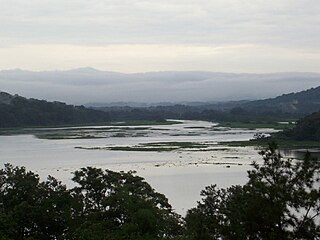 W
WEncarnación, was an armed Spanish merchant ship of the Nao class, which was built in Veracruz, Viceroyalty of New Spain, likely sometime in the mid-1600s. The ship sank in a storm in 1681 at the mouth of the Chagres River and was discovered by archaeologists from the Texas State University in 2011.
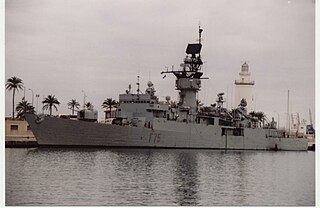 W
WExtremadura (F75) is the fifth ship of five Spanish-built Baleares-class frigates, based on the American Knox class design, of the Spanish Navy.
 W
WGalicia, was a Spanish third-rate ship of the line of the Kingdom of Spain's Armada Real in service between 1750 and 1797.
 W
WGeneral Concha was a General Concha-class Cañonero (gunboat) or more technically "Third Class non-armored Cruiser" of the Spanish Navy which fought at San Juan, Puerto Rico, during the Spanish–American War.
 W
WUSS Iona was a wooden-hulled, harbor tug of the United States Navy that served during World War II.
 W
WJorge Juan was a Jorge Juan-class sloop of the Spanish Navy which was sunk off Cuba during the Spanish–American War.
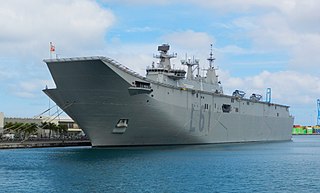 W
WJuan Carlos I is a multi-purpose amphibious assault ship-aircraft carrier in the Spanish Navy. Similar in role to many aircraft carriers, the ship has a ski jump for STOVL operations, and is equipped with the AV-8B Harrier II attack aircraft. The vessel is named in honour of Juan Carlos I, the former King of Spain.
 W
WJuan Sebastián de Elcano is a training ship of the Spanish Navy. It is a four-masted topsail, steel-hulled barquentine. At 113 metres (371 ft) long, it is the third-largest tall ship in the world, and is the sailing vessel that has sailed the furthest, covering more than 2,000,000 nautical miles in its lifetime.
 W
WUSS Capps (DD-550), a Fletcher-class destroyer, was a ship of the United States Navy named for Rear Admiral Washington L. Capps (1864–1935).
 W
WThis is a list of active Spanish Navy ships, complete and correct as of December 2016. There are approximately 77 vessels in the Navy, including minor auxiliary vessels. A breakdown includes; one amphibious assault ship, two amphibious transport docks, 11 frigates, three submarines, six mine countermeasure vessels, 22 patrol vessels and a number of auxiliary ships. The total displacement of the Spanish Navy is approximately 225,000 tonnes.
 W
WMar Negro was an armed merchantman of the Nationalist Spanish Navy during the Spanish Civil War. The cargo ship was launched in 1930 along with her sister ship MV Mar Cantábrico, and after five years with the Compañía Marítima Del Nervión company, she was first requisitioned by the Spanish Republican Navy in 1936. Captured by a group of Nationalist sympathizers from her crew off Algeria in 1937, she entered in service in 1938 after being converted to an auxiliary cruiser.
 W
WMeteoro (P-41) is the lead ship of the Meteoro class, a new kind of offshore patrol vessel created for the Spanish Navy and called BAMs.
 W
WThe Mexicana was a topsail schooner built in 1791 by the Spanish Navy at San Blas, New Spain. It was nearly identical to the Sutil, also built at San Blas later in 1791. Both vessels were built for exploring the newly discovered Strait of Georgia, carried out in 1792 under Dionisio Alcalá Galiano, on the Sutil, and Cayetano Valdés y Flores, on the Mexicana. During this voyage the two Spanish vessels encountered the two British vessels under George Vancouver, HMS Discovery and Chatham, which were also engaged in exploring the Strait of Georgia. The two expeditions cooperated in surveying the complex channels between the Strait of Georgia and Queen Charlotte Strait, in the process proving the insularity of Vancouver Island. After this first voyage the Mexicana continued to serve the San Blas Naval Department, making various voyages to Alta California and the Pacific Northwest coast.
 W
WNavarra (F85) is the fifth of the six Spanish-built Santa Maria-class frigates, based on the American Oliver Hazard Perry-class design, of the Spanish Navy.
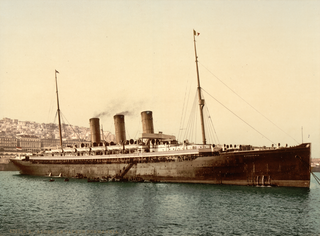 W
WRMS Normannia was a German ocean liner owned by the Hamburg America Line and built by Fairfield Shipbuilding and Engineering Company of Govan, Scotland. She was launched on Sunday, 9 February 1890.
 W
WNuestra Señora del Rosario, was a Spanish first-rate ship of the line of the Kingdom of Spain's Armada Real in service between 1587 and 1588.
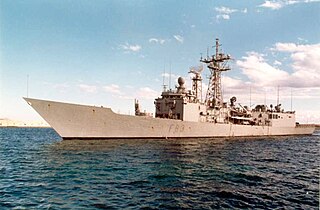 W
WNumancia (F83) is the third of the six Spanish-built Santa Maria-class frigates, based on the American Oliver Hazard Perry class design, of the Spanish Navy.
 W
WPatiño is a replenishment oiler of the Spanish Navy. It was named after the Spanish navy minister José Patiño Rosales, who reorganized the fleet on the orders of Philip V of Spain. The vessel was ordered in 1991 from Navantia and built at their yard in Ferrol, Galicia. The ship entered service with the Spanish Navy in June 1995 and is homeported at Ferrol. Patiño has been deployed with NATO forces around the world, participating in missions in the Kosovo War, the War in Afghanistan along with the European Union's anti-piracy mission to Somalia.
 W
WPurísima Concepción, was a Spanish first-rate ship of the line of the Kingdom of Spain's Armada Real in service between 1779 and 1810.
 W
WUSS Quiros (PG-40), previously designated Gunboat No. 40, was a United States Navy gunboat in commission from 1900 to 1904, from 1904 to 1908, and from 1910 to 1923, seeing service in the Philippines and China. Prior to her U.S. Navy service, she was in commission in the Spanish Navy from 1896 to 1898 as Quirós, seeing service during the Philippine Revolution and the Spanish–American War.
 W
WRayo (P-42) is the second ship of the Meteoro class, a new kind of offshore patrol vessel created for the Spanish Navy and called BAMs.
 W
WReal was a Spanish galley and the flagship of Don John of Austria in the Battle of Lepanto in 1571.
 W
WReina Sofía (F-84) is the fourth of six Spanish-built Santa Maria-class frigates, based on the American Oliver Hazard Perry-class design, of the Spanish Navy.
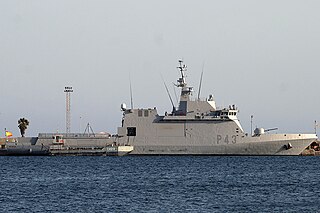 W
WRelámpago (P-43) is the third ship of the Meteoro class, a new kind of offshore patrol vessel created for the Spanish Navy and called BAMs.
 W
WSpanish expeditions to the Pacific Northwest were undertaken several times during the Age of Exploration. Spanish claims to the Pacific Northwest date to the papal bull of 1493, and the Treaty of Tordesillas signed in 1494. In 1513, this claim was reinforced by Spanish explorer Vasco Núñez de Balboa, the first European to sight the Pacific Ocean, when he claimed all lands adjoining this ocean for the Spanish Crown. Spain only started to colonize the claimed territory north of present-day Mexico in the 18th century, when it settled the northern coast of Las Californias.
 W
WSan Salvador was a Spanish galleon of the Spanish Armada as part of the Guipúzcoan squadron of Miguel de Oquendo. She was damaged and captured as a result of the first encounter of the Armada with the Royal Navy in 1588. San Salvador was lost at sea in the English Channel later that same year.
 W
WSan Telmo was a Spanish 74-gun ship of the line, launched in 1788.
 W
WSanta María (F81) is the lead ship of six Spanish-built Santa Maria-class frigates, based on the American Oliver Hazard Perry class design, of the Spanish Navy.
 W
WThe Santa María class of frigates is the Spanish Navy's designation for six locally built warships based on the United States Oliver Hazard Perry-class frigates.
 W
WHMS Prince William was a 64-gun third-rate ship of the line of the Royal Navy. She had previously been Nuestra Señora de la Asunción, but was better known as Guipuzcoano, an armed merchantmen of the Spanish Basque Guipuzcoan Company of Caracas.
 W
WPoseidon (A-12) was a salvage and support vessel for submarines of the Spanish Navy, ceded in 2000 to Mauritania where it served with the name Voum-Legleita (B-551) until its sinking in February 2011.
 W
WSutil was a brig-rigged schooner built in 1791 by the Spanish Navy at San Blas, New Spain. It was nearly identical to Mexicana, also built at San Blas in 1791. Both vessels were built for exploring the newly discovered Strait of Georgia, carried out in 1792 under Dionisio Alcalá Galiano, on Sutil, and Cayetano Valdés y Flores, on Mexicana. During this voyage the two Spanish vessels encountered the two British vessels under George Vancouver, HMS Discovery and HMS Chatham, which were also engaged in exploring the Strait of Georgia. The two expeditions cooperated in surveying the complex channels between the Strait of Georgia and Queen Charlotte Strait, in the process proving the insularity of Vancouver Island. After this first voyage Sutil continued to serve the San Blas Naval Department, making various voyages to Alta California and the Pacific Northwest coast.
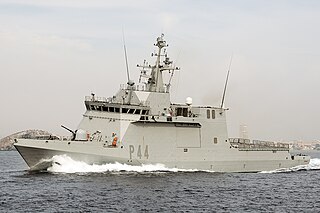 W
WTornado (P-44) is the fourth ship of the Meteoro class, a new kind of offshore patrol vessels created for the Spanish Navy and called BAMs.
 W
WVictoria (F82) is the second of the six Spanish-built Santa Maria-class frigates, based on the American Oliver Hazard Perry class design, of the Spanish Navy.
 W
WUSS Villalobos (PG-42) was a steel screw gunboat originally built for the Spanish Navy as Villalobos but captured by the United States Army in 1898 during the Spanish–American War and commissioned into the United States Navy in 1900. The ship spent almost all of her life as an American gunboat in the Yangtze Patrol on the Yangtze River.
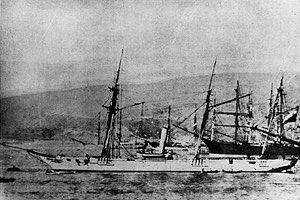 W
WThe schooner Virgen de Covadonga was a ship that participated in the Chincha Islands War and the War of the Pacific, under Spanish and Chilean flags. She was launched in 1859. Covadonga hit a floating mine and sank off Chancay in 1880.